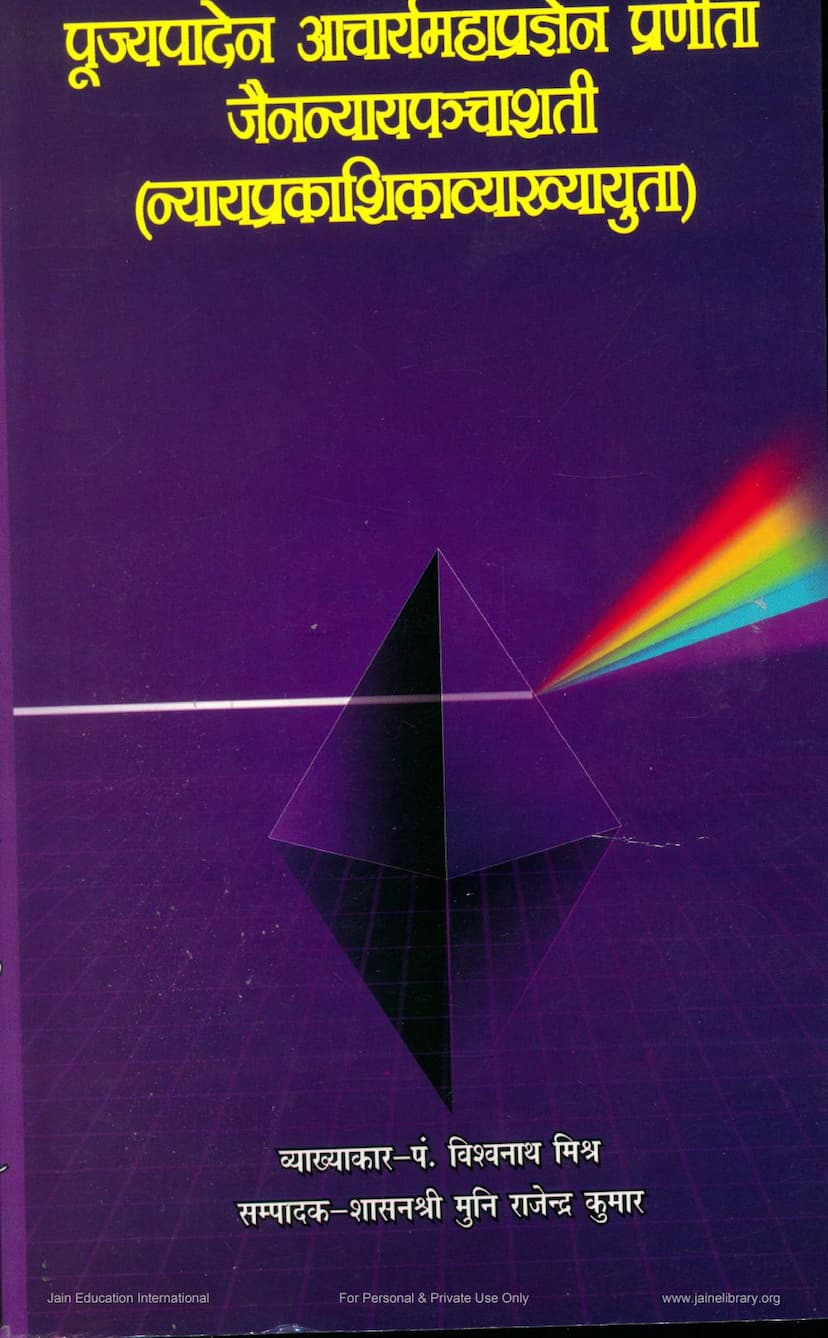Jain Nyaya Panchashati
Added to library: September 2, 2025

Summary
Here is a comprehensive summary in English of the Jain text "Jain Nyaya Panchashati" with its commentary "Nyayaprakashika," based on the provided pages:
Book Title: Jain Nyaya Panchashati (with Nyayaprakashika Commentary) Author: Acharya Mahapragya Commentator (Nyayaprakashika): Pt. Vishwanath Mishra Editor: Shasanashri Muni Rajendrakumar Publisher: Jain Vishva Bharati Institute, Ladnun
Overall Purpose: "Jain Nyaya Panchashati" is a concise work by the esteemed Acharya Mahapragya, presented in fifty verses (shlokas). It serves as an accessible introduction to Jain logic (Nyaya) for those seeking to understand its fundamental principles. The commentary, "Nyayaprakashika," penned by Pt. Vishwanath Mishra, further elucidates these concepts in Sanskrit, with a Hindi translation provided for broader accessibility. The book aims to clarify core tenets of Jain philosophy, particularly within the domain of logic and epistemology.
Key Themes and Arguments Discussed:
-
The Nature of Pramana (Means of Valid Knowledge):
- The book emphasizes the central role of Pramana in acquiring knowledge, stating that the reality of objects (prameya) is established through valid means of knowledge.
- It critically examines various philosophical views on what constitutes Pramana, particularly refuting the Nyaya school's emphasis on sensory contact (sannikarsa) as the sole or primary instrument.
- The text argues that true Pramana is knowledge itself, which is inherently self-luminous and capable of revealing both itself and other objects. This is illustrated with the analogy of a lamp.
- The debate on whether knowledge is self-valid (svatah pramana) or extrinsically validated (paratah pramana) is explored, with Jainism asserting a combination of both based on context (e.g., practice vs. non-practice).
-
Critique of Other Philosophical Schools:
- Buddhism (Sautrantika): The book refutes the Buddhist theory that knowledge arises from and takes the form of its object (tad-utpatti-tad-akaratā). The analogy of the lamp not taking the form of the object it illuminates is used to counter this.
- Nyaya and Vaisheshika: The text criticizes the Nyaya school's view that sensory contact (sannikarsa) is Pramana, highlighting its inert nature and the issue of avyapti (under-extension). It also challenges the Vaisheshika assertion of separate ontological categories for "Gat-kav" (generalities) and "Vishesha" (particularities), arguing they are inherent qualities of the object, not independent entities.
- Mimamsa: The Mimamsa school's concept of validity arising from the causal factors of knowledge is discussed and implicitly critiqued.
-
Classification of Knowledge (Pramana):
- Direct vs. Indirect (Pratyaksha vs. Paroksha): Knowledge is divided into direct (Pratyaksha) and indirect (Paroksha).
- Pratyaksha (Direct): This is further categorized into:
- Samvyavaharika Pratyaksha: Perceptual knowledge involving sensory organs and the mind. It includes Avagraha (initial apprehension), Isha (investigation), Avaya (determinate knowledge), and Dharana (retention). These are further analyzed based on the five senses and the mind, totaling 28 types of Mati-jnana (sensory and mental cognition).
- Paramarthika Pratyaksha: The ultimate, pure, and unobstructed knowledge of the soul, such as Kevala Jnana (omniscience), which is independent of external means.
- Paroksha (Indirect): This includes:
- Smriti (Memory): Knowledge derived from past impressions.
- Pratyabhijna (Recognition): Knowledge combining present perception with past memory (e.g., "This is that Devadatta").
- Tarka (Reasoning): Logical inference based on the principle of concomitance (anvay-vyatireka).
- Anumana (Inference): Drawing a conclusion based on a probans (hetu) and probandum (sadhyam) linked by invariable concomitance.
- Agama (Testimonial Knowledge): Knowledge derived from the teachings of reliable sources (Apta).
- Pratyaksha (Direct): This is further categorized into:
- Direct vs. Indirect (Pratyaksha vs. Paroksha): Knowledge is divided into direct (Pratyaksha) and indirect (Paroksha).
-
The Nature of Reality (Sat):
- The book expounds on the Jain concept of Sat (that which exists) as possessing three characteristics: Utpada (origination), Vyaya (destruction), and Dhrouvya (permanence).
- This is exemplified through analogies like the Ganga river (always flowing, yet the river remains) and a bubble (constantly forming and disappearing, yet it is still water).
- The concept of Dravya (substance) and Paryaya (modes/attributes) is central here. Dravya provides the permanent aspect (Dhrouvya), while Paryayas undergo change (Utpada and Vyaya). This explains how a single substance can undergo transformation while retaining its essential nature.
-
Analysis of Specific Concepts:
- Word (Shabda): Shabda is argued to be a collection of Pudgala (matter particles) and therefore has materiality (murta), contrary to some other philosophical views that consider it a quality of Akash (ether). It is also classified as sentient (sachitta), inert (achitta), or mixed (mishra) based on its origin.
- Darkness (Tamas): The text argues that darkness is a substance (dravya) because it possesses qualities (like color – blue/black) and perceived actions (like movement), making it a substrate for qualities and actions, as defined in some logical systems. It refutes the idea that darkness is merely the absence of light, asserting its own positive existence as a material entity.
- The Soul (Atma): The soul is described as possessing innumerable regions (pradeshas), all of which are fundamentally conscious and luminous (jnanamaya/chaitanyamaya). It asserts the soul's independence and non-derivability of consciousness from external sources or reflection, countering theories of the soul being a mere reflection of a divine entity.
-
Linguistic and Philosophical Nuances:
- The text delves into the importance of context and perspective (Naya) in understanding reality, particularly highlighting the Jain doctrine of Syadvada (the doctrine of conditioned predication) which allows for multiple, seemingly contradictory descriptions of an object depending on the viewpoint.
- The concept of Anekanta (non-absolutism or manifoldness of reality) underpins the entire philosophical discussion.
Structure and Presentation: The book is structured with an introduction by prominent figures, followed by Acharya Mahapragya's original verses. Pt. Vishwanath Mishra's elaborate commentary "Nyayaprakashika" provides detailed explanations, philosophical arguments, refutations of opposing views, and analogies. The inclusion of an editor's note by Muni Rajendrakumar and the biographical sketch of Acharya Mahapragya further enrich the publication. Appendices with a glossary of technical terms and etymological explanations are also provided.
In essence, "Jain Nyaya Panchashati" is a significant contribution to understanding Jain logic, presenting complex philosophical ideas in a structured and accessible manner, amplified by a detailed and insightful commentary.